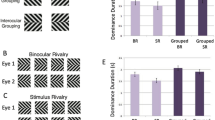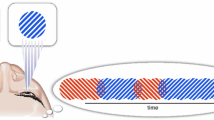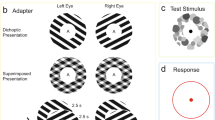Abstract
We investigated binocular rivalry in the twocerebral hemispheres of callosotomized(split-brain) observers. We found that rivalryoccurs for complex stimuli in split-brainobservers, and that it is similar in the twohemispheres. This poses difficulties for twotheories of rivalry: (1) that rivalry occursbecause of switching of activity between thetwo hemispheres, and (2) that rivalry iscontrolled by a structure in the rightfrontoparietal cortex. Instead, similar rivalryfrom the two hemispheres is consistent with atheory that its mechanism is low in the visualsystem, at which each hemisphere conducts asimilar analysis of its half of visual space.
Similar content being viewed by others
References
Blake, R., 2001: A primer on binocular rivalry, including current controversies. Brain and Mind 2, 5-38.
Blake, R. andBoothroyd, K., 1985: The precedence of binocular fusion over binocular rivalry. Perception and Psychophysics 37, 114-124.
Blake, R.,O'shea, R.P. andMueller, T.J., 1992: Spatial zones of binocular rivalry in central and peripheral vision. Visual Neuroscience 8, 469-478.
Fox, R. andCheck, R., 1966: Forced-choice form recognition during binocular rivalry. Psychonomic Science 6, 471-472.
Funnell, M.G.,Corballis, P.M. andGazzaniga, M.S., 2000: The split brain. In F. Boller,J. Grafman andG. Rizzolatti (eds), Handbook of Neuropsychology, 2nd edn, Vol. 1, Amsterdam: Elsevier, pp. 103-120.
Gazzaniga, M.S., 1965: Psychological properties of the disconnected hemispheres in man. Science, 150, 372.
Gazzaniga, M.S., 1966: Interhemispheric communication of visual learning. Neuropsychologia 4, 183-189.
Gazzaniga, M.S., 2000: Cerebral specialization and interhemispheric communication: Does the corpus callosum enable the human condition? Brain 123, 1293-1326.
Gazzaniga, M.S.,Bogen, J.E. andSperry, R.W., 1962: Some functional effects of sectioning the cerebral commissures in man. Proceedings of the National Academy of Sciences of the United States of America 48, 1765-1769.
Gazzaniga, M.S.,Bogen, J.E. andSperry, R.W., 1965: Observations on visual perception after disconnection of the cerebral hemispheres in man. Brain 88, 221-236.
Gazzaniga, M.S.,Holzman, J.D.,Deck, M.D.E. andLee, B.C.P., 1985: MRI assessment of human callosal surgery with neuropsychological correlates. Neurology 35, 682-685.
Gross, C.G.,Rodman, H.R.,Gochin, P.M. andColombo, M.W., 1992: Inferior temporal cortex as a pattern recognition device. Computational learning and cognition: Proceedings of the Third NEC Research Symposium. Philadelphia: Siam, pp. 44-73.
Kanwisher, N.,McDermott, J. andChun, M.M., 1997: The fusiform face area: A module in human extrastriate cortex specialized for face perception. Journal of Neuroscience 17, 4302-4311.
Lumer, E.D., Friston, K.J. and Rees, G.: Neural correlates of perceptual rivalry in the human brain. Science 280, 1930-1934.
Lumer, E.D. andRees, G., 1999: Covariation of activity in visual and prefrontal cortex associated with subjective visual perception. Proceedings of the National Academy of Sciences of the United States of America 96, 1669-1673.
Miller, S.M., 2001: Binocular rivalry and the cerebral hemispheres. Brain and Mind 2, 119-149.
Miller, S.M.,Liu, G.B.,Ngo, T.T.,Hooper, G.,Riek, S.,Carson, R.G. andPettigrew, J.D., 2000: Interhemispheric switching mediates perceptual rivalry. Current Biology 10, 383-392.
Mueller, T.J., 1990: A physiological model of binocular rivalry. Visual Neuroscience 4, 63-73.
O'shea, R.P. andCorballis, P.M., 2000: Binocular rivalry in a split-brain observer [Abstract]. Investigative Ophthalmology and Visual Science 41(4), S732.
O'shea, R.P. and Corballis, P.M., in preparation: Binocular rivalry in split-brain observers. Neuro-Report.
Pettigrew, J.D. andMiller, S.M., 1998: A 'sticky' interhemispheric switch in bipolar disorder? Proceedings of the Royal Society London, Series B Biological Sciences 265, 2141-2148.
Ramachandran, V.S., 1994: Phantom limbs, neglect syndromes, repressed memories, and Freudian psychology. International Review of Neurobiology 37, 291-333.
Seymour, S.E.,Reuter-Lorenz, P.A. andGazzaniga, M.S., 1994: The disconnection syndrome: Basic findings reaffirmed. Brain 117, 105-115.
Shimojo, S. andNakayama, K., 1990: Real world occlusion constraints and binocular rivalry. Vision Research 30, 69-80.
Steiner, V.,Blake, R. andRose, D., 1994: Interocular transfer of expansion, rotation, and translation motion aftereffects. Perception 23, 1197-1202.
Tanaka, K., 1992: Inferotemporal cortex and higher visual functions. Current Opinion in Neurobiology 2, 502-505.
Tanaka, K.,Saitoo, H.-A.,Fukada, Y. andMoriya, M., 1991: Coding visual images of objects in the inferotemporal cortex of the Macaque monkey. Journal of Neurophysiology 66, 170-189.
Tong, F.,Nakayama, K.,Vaughan, J.T. andKanwisher, N., 1999: Binocular rivalry and visual awareness in human extrastriate cortex. Neuron 21, 753-759.
Author information
Authors and Affiliations
Rights and permissions
About this article
Cite this article
O'Shea, R.P., Corballis, P.M. Binocular Rivalry between Complex Stimuli in Split-Brain Observers. Brain and Mind 2, 151–160 (2001). https://doi.org/10.1023/A:1017989820832
Issue Date:
DOI: https://doi.org/10.1023/A:1017989820832




